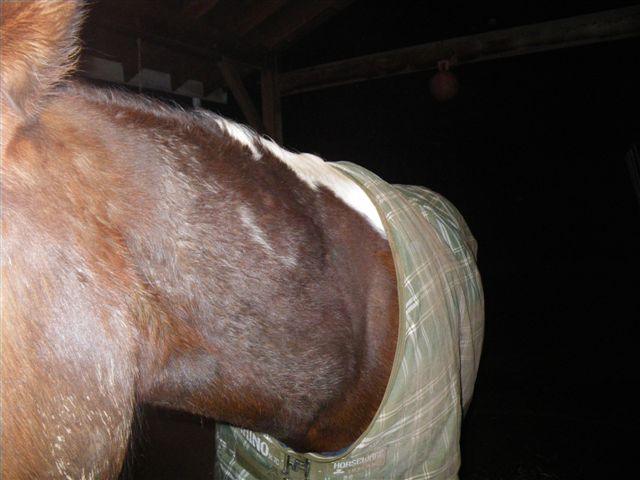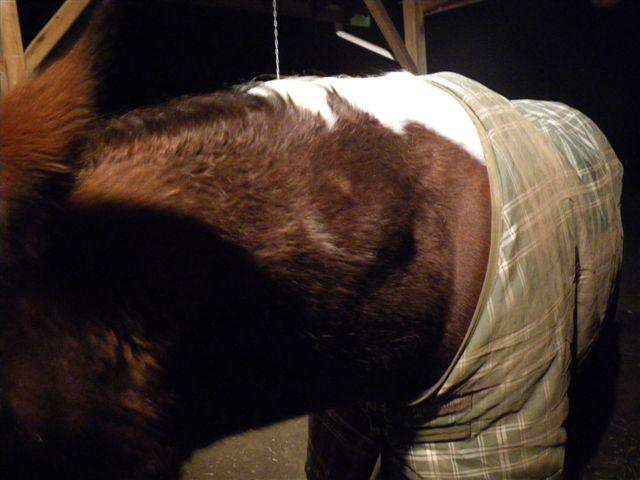| Home Medical Index | First Posted: Mar 2007 Jan 21, 2020 | |
Equine Herpes Virus 1 (EHV-1)Rhino/Flu - "FLU/RHINO" - Intramuscular Influenza and Rhinopneumonitis vaccine. Rhino/flu combination vaccine is a vaccine containing influenza strains and rhinopneumonitis EHV-4. This combination vaccine is often given to horses. Show horses, race horses, or horses in a high-exposure situation may need rhino/flu vaccines every three to four months. Sometimes large boarding stables or stables who buy, sell, and board will also give Rhino/Flu 3 or four times a year. I USE to give our horses Rhino/Flu in the Spring and then again in the Fall. My horse, A Patchy, has always had a slight reaction to this shot. Because of that we premedicated him with bute and also gave him trihist the night before the shot and continued to give the trihist depending upon the reaction. This spring, A Patchy had a large localized reaction to the shot. We gave it in his neck, as always, and his neck blew up with a lump the size of a grapefruit. No kidding! I have provided you with pictures below. He is fine, but it took a week for this swelling to go down. He was never in any visual distress. His eating was fine and he was not listless or showing any other signs He did not spike a fever or run a low-grade fever. There was just heat and swelling. I will not give him the shot anymore. Also, I want to add that my husband's horse, Rusty, will not be receiving the shot either. Through my research for HorseHints, I found that horses with uveitis or neck threadworms (Onchocera), (Microfilariae), should probably not have the shot, as well. The shot has been shown to cause a flare-up of uveitis in some of these horses.    Equine Rhinopneumonitis Virus
Update: "As part of the Maryland Department of Agriculture's (MDA) ongoing work to expedite the identification and control of disease, the College Park Animal Health Diagnostic Laboratory is now able to perform polymerase chain reaction (PCR) testing for equine herpesvirus-1 (EHV-1), the causal agent of a common equine respiratory disease that's often called "rhino" (short for rhinopneumonitis). This test includes the capability to detect the neuropathic strain of the virus that causes neurologic herpes (equine herpes myeloencephalopathy), a form of EHV-1 that is often fatal." UC Davis has had this availability. Equine Herpes Virus EHV-1 This year, 2007, a number of racetracks, equine hospitals, and barns had outbreaks of EVH-1 across the country. In Virginia, the famous horse hospital facility, in Leesburg, went into quarantine. Several barns in Virginia, Maryland and Pennsylvania did the same. Equine competitions and gatherings around the area cancelled their functions until the outbreak passed. Many barns did not let any outside horses into their facility. My vet suggested that we keep our horses on the property and not allow any outside horses in until the all clear was given. There are two forms of Equine Herpes Virus 1 (EHV-1). One causes pregnant mares to abort. The other causes respiratory infection and neurological problems in horses. (Myeloencephalopathy) In short, it causes damage to the spinal cord, the brain, or both. The neurological form has a high mortality rate. This virus knows no barriers. The virus is resistant to vaccination and attacks all breeds and ages. It is interesting to note that most horses have been exposed to EVH-1 by two years of age. It has been documented throughout the world. This virus is much like Herpes Simplex Type 1 in humans. In fact, often after the horse has been exposed the virus, the virus remains latent much like Herpes Simplex Type 1 in humans. The horse may not show any clinical signs at all. A major concern of researchers and vets is, that because of this latency and lack of clinical signs, an affected horse could be transmitting the disease unknowingly. Researchers believe that there is evidence that supports the observation that a more virulent strain has emerged of the neurological form of EVH-1. They believe that the strain may have mutated. Its ability to reproduce more rapidly and to create very high levels of EHV leads to death.
How is EHV-1 Transmitted?
EHV-1 virus is spread by direct contact of one horse to another, by contaminated hands, equipment, tack, and for a brief time through the air. It is very important to make sure that the horse's environment is kept as clean as possible. It is also imperative that horses affected by the virus be isolated from the rest of their stable mates. Quarantine is best.
What Happens to the Affected Horse?
The neurological form of EHV-1 causes inflammation of the blood vessels, the formation of clots, obstruction of blood flow in the circulatory system, and hemorrhage into the nerve tissues. It is believed that stress factors such as transporting your horse, strenuous exercise, fatigue, and immune system problems may be factors that cause the virus to resurface and clinical signs may present.
Clinical Signs of EHV-1
If the neurological strain is present the horse may present with:
Incubation Period
Prevention
There are vaccines available for the respiratory and abortive forms of EHV-1. To date, there is no vaccine for protection against the neurological strain of the virus. Isolation, quarantine, cleanliness, and good management practices help to prevent infectious agents into a stable. UC Davis Center for Equine Health is doing extensive research on EHV-1. Another article on Equine Herpes Virus (EVH-1) Equine Rhinopneumonitis Virus (EHV-1) is available. |